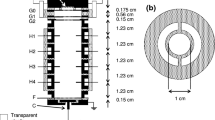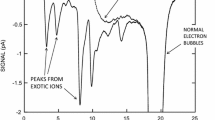Abstract
In 1970, Doake and Gribbon reported the discovery of a negative ion in superfluid helium that has a mobility about six times higher than the mobility of the normal electron bubble. We report on measurements of the variation of the mobility of this “fast ion” with applied pressure.
Similar content being viewed by others
Avoid common mistakes on your manuscript.
1 Introduction
There are now at least 19 different negative ions that have been detected in superfluid helium-4. However, for only one of these, the so-called normal electron bubble, or NEB, is the structure known. As a result of many experiments, it is clear that the NEB is a bubble of radius about \(19\, \mathrm{\AA }\) containing an electron and no helium atoms. This structure was first proposed by Careri [1, 2] following on from a proposal by Ferrell [3] to explain the anomalously long lifetime of positronium in liquid helium. The 18 other ions have a higher mobility than the NEB and have been seen in several experiments [4,5,6,7,8,9,10,11,12,13]. Doake and Gribbon were the first to report the existence of one of these ions [4]. The ion they detected has the highest mobility of all of the ions, about six times the mobility of the NEB, and is referred to as the “fast ion”.
There is no generally accepted theory of these ions, see discussion in Ref. [13], and for some more recent work, see Refs. [14, 15]. Clearly more experimental results are needed to clarify the situation. So far, only two properties of the ions have been studied:
-
(i)
The ion mobility has been measured in the temperature range from 1 K to about 1.2 K. In most of the experiments, the ions have been produced by creating a plasma in the saturated vapor above the surface of the liquid. The density of the vapor increases rapidly as the temperature goes up, and above 1.2 K, it is hard to maintain a stable plasma. The energy dissipated in the plasma makes it hard to perform experiments below 1 K.
-
(ii)
Measurements have been taken of the critical velocity at which moving ions nucleate quantized vortices and become trapped [8, 9]. It was found that this critical velocity was larger for the exotic ions of higher mobility. For the fast ion, vortex nucleation was not observed even when the ion velocity approached the Landau critical velocity.
From these reports, it is not clear whether the fast ion is simply the exotic ion that has the highest mobility or whether it is an ion that has a different structure from the other exotic ions. In favor of the latter view, we note that in the experiment of Doake and Gribbon [4] a radioactive \(\alpha \) source instead of a plasma was used to generate ions, and they reported the mobility of only the fast ion. In another experiment, we have found that when we have generated ions by means of a sharp tip immersed in the liquid, rather than a tip in the vapor, only the fast ion and the NEB were seen [12]. To be clear, we will use the term “intermediate ions” to refer to all of the negative ions with higher mobility than that of the NEB but excluding the fast ion.
To add to the information about the ions, we report here measurements of the variation of the mobility of the fast ion with liquid pressure.
2 Experiment
The apparatus used for the experiment was a modified version of the mobility cell described in an earlier paper [13]. A \(300\, \upmu \mathrm{Ci}\) Americium \(\alpha \)-source was mounted in the liquid at the top of the cell. The energy of the \(\alpha \)’s is 5.5 MeV, and the range in liquid helium is approximately \(250\, \upmu \mathrm{m}\). A high density of both positive and negative charges is produced along the \(\alpha \)-track. An upward electric field was applied in the liquid region near to the source. The purpose of this field was not only to drive negatively charged ions down into the lower part of the cell where the mobility measurement is taken, but also to increase the fraction of the positive and negative ion pairs along the \(\alpha \)-track which do not recombine. After leaving the region near to the source, the stream of negative ions passes though a pair of gate grids. These grids allow for ions to enter the drift region below for a short time \((\sim 0.5\hbox { ms})\). The ion mobility is determined by the time it takes the ions to go from the gate to a collector at the bottom of the drift region. Measurements were taken with a drift field of \(65 \,\mathrm{V}\ \mathrm{cm}^{-1}\). The experimental cell was not designed for work at high pressure, and so, we had to limit the pressure range to less than 6 bars. We were able to detect strong signals from the NEB and from positive helium ions. The signal from fast ions was smaller by a factor of about 10. We were unable to detect any signal from the intermediate ions.
In Fig. 1, we plot the mobility of the NEB as a function of pressure. The temperature is 0.987 K. Figure 2 shows the mobility of the positive helium ion, also at 0.987 K. The uncertainty in the measurement of the mobility is estimated to be less than 0.2 %. The results in these figures show the same general behavior that has been found by Brody at higher temperatures [16, 17], i.e., the mobility of the NEB first increases when the pressure is increased and then decreases, while the mobility of the positive ion decreases monotonically as the pressure increases. One can understand the results for the NEB by noting that the mobility \({{\mu }_{\mathrm{NEB}}}\) should vary as
where \({{D}_{\mathrm{NEB}}}\) is the drag exerted by rotons on the ion surface per unit area and unit velocity and R is the radius of the bubble. At temperatures in the vicinity of 1 K, the drag will be proportional to the roton number density and so
where \(\varDelta \) is the roton energy. Since \(\varDelta \) decreases with increasing pressure, the drag increases with pressure. At the same time, the radius of the NEB decreases with increasing pressure. When the pressure is small, the rate of decrease in R is sufficient to result in the mobility increasing despite the increase in \({{D}_{\mathrm{NEB}}}\). However, as the pressure increases, the bubble becomes less compressible while \({{D}_{\mathrm{NEB}}}\) continues to increase, and so the mobility decreases. We can take the energy of the NEB to be given by
where \(\alpha \) is the surface tension (0.3677 erg cm\(^{-2}\) at 1 K) and m is the electron mass. The bubble radius as a function of pressure is as shown by the solid curve in Fig. 3. Using this result combined with the measured mobility, data give the drag coefficient shown in Fig. 3 as the dashed curve.
Solid curve shows the calculated radius of the normal electron bubble as found from Eq. (3). The dashed curve is the drag coefficient \({{D}_{\mathrm{NEB}}}\) calculated from the mobility of the normal electron bubble using the method described in the text (Color figure online)
In Fig. 4, we show the results of measurements of the mobility \({{\mu }_{\mathrm{fast}}}\) of the fast ion. If the drag coefficient for the fast ion is \(D_{\mathrm{fast}}\), then the radius \({{R}_{\mathrm{fast}}}\) of the fast ion is given by
If we assume that the drag coefficient for the fast ion is the same as the coefficient for the NEB, we find the radius of the fast ion to be \(7.4~\mathrm{\AA }\) with no significant variation with pressure (Fig. 5). However, since the structure of the fast ion is not known, we cannot be sure that \(D_{\mathrm{fast}}\) and \(D_{\mathrm{NEB}}\) are equal.
3 Discussion
The absence of a signal from the intermediate ions in this experiment supports the conclusion already drawn from previous experiments that the fast ion has a different structure from the intermediate ions. The intermediate ions and the fast ion have both been seen when negative charge enters the liquid from a plasma discharge in helium vapor, but only the fast ion appears when an \(\alpha \) particle enters the liquid [12] or when a sharp tip is immersed in the liquid [12].
Although the experiment does provide new information about the properties of the fast ion, the structure of the fast ion remains a mystery. The possibility that the ion is the \(1{s}2{s}2{p}\,{^4}\!P\) helium ion was considered by Ihas and Sanders [5, 6] and rejected because the lifetime is much less than the time for the fast ion to pass through the drift region. For a further discussion, see Ref. [13].
The absence of a significant change in the radius of the ion when pressure is applied is not surprising. In order for the ion to have a radius of \(7.4 \,\mathrm{\AA }\), the binding of the extra electron to whatever forms the core of this ion must be strong. As a result, the variation of the bubble size with changes in pressure will be small.
Superfluid helium contains only a very small number density of impurities, but one can consider the possibility that the fast ion is produced from impurities frozen onto the wall of the cell. In the present experiment, there is no helium vapor plasma, and so the impurities cannot be knocked off the wall by collisions with helium atoms with high kinetic energy. It is conceivable that helium ions or excited helium atoms produced by an \(\alpha \) particle can diffuse through the liquid and release enough energy to knock an impurity off the wall. The \(\alpha \)’s also produce high-energy photons which propagate freely through the liquid and deposit energy on the cell walls.
References
G. Careri, F. Scaramuzzi, J.O. Thomson, Nuovo Cimento 13, 186 (1959)
G. Careri, U. Fasoli, F.S. Gaeta, Nuovo Cimento 15, 774 (1960)
R.A. Ferrell, Phys. Rev. 108, 167 (1957)
C.S.M. Doake, P.W.F. Gribbon, Phys. Lett. 30A, 251 (1969)
G.G. Ihas, T.M. Sanders, Phys. Rev. Lett. 27, 383 (1971)
G.G. Ihas, Ph.D. thesis, University of Michigan (1971)
G.G. Ihas, T.M. Sanders, in Proceedings of the 13th International Conference on Low Temperature Physics, ed. by K.D. Timmerhaus, W.J. O’Sullivan, E.F. Hammel (Plenum, New York, 1972), Vol. 1, p. 477
V.L. Eden, P.V.E. McClintock, in 75th Jubilee Conference on Liquid\({^4}\)Helium, ed. by J.G.M. Armitage (World Scientific, Singapore, 1983), p. 194
V.L. Eden, P.V.E. McClintock, Phys. Lett. 102A, 197 (1984)
V.L. Eden, M. Phil. thesis, University of Lancaster (1986)
C.D.H. Williams, P.C. Hendry, P.V.E.McClintock, Proceedings of the 18th International Conference on Low Temperature Physics, Jpn. J. Appl. Phys. 26(supplement 26-3), 105 (1987)
W. Wei, Z. Xie, G.M. Seidel, H.J. Maris, J. Phys. Conf. Ser. 400, 012042 (2012)
W. Wei, Z. Xie, L.N. Cooper, G.M. Seidel, H.J. Maris, J. Low Temp. Phys. 178, 78 (2015)
A.G. Khrapak, S.Ya. Bronin, JETP Lett. 105, 797 (2017)
F. Aitken, F. Volino, L.G. Mendoza-Luna, K. Von Haeften, J. Eloranta, Phys. Chem. Chem. Phys. 19, 15821 (2017)
B. Brody, Phys. Rev. B 11, 170 (1975)
B.A. Brody, Ph.D. thesis, University of Michigan (1970)
Acknowledgements
We thank Jussi Eloranta and Wei Guo for helpful discussions.
Author information
Authors and Affiliations
Corresponding author
Additional information
Publisher's Note
Springer Nature remains neutral with regard to jurisdictional claims in published maps and institutional affiliations.
Rights and permissions
About this article
Cite this article
Sirisky, S., Xing, Y., Seidel, G.M. et al. Investigation of the Fast Negative Ion in Superfluid Helium-4. J Low Temp Phys 201, 122–127 (2020). https://doi.org/10.1007/s10909-019-02308-1
Received:
Accepted:
Published:
Issue Date:
DOI: https://doi.org/10.1007/s10909-019-02308-1









